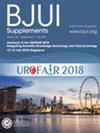Impact of the R.E.N.A.L. complexity score on outcomes of stereotactic ablative body radiotherapy for primary renal cell carcinoma
IF 3.7
2区 医学
Q1 UROLOGY & NEPHROLOGY
引用次数: 0
Abstract
ObjectiveTo evaluate the predictive value of the R.E.N.A.L. ([R]adius, [E]xophytic/endophytic properties, [N]earness of tumour to the collecting system or sinus, [A]nterior/posterior descriptor, and [L]ocation relative to polar lines) nephrometry score (RNS) for outcomes following stereotactic ablative body radiotherapy (SABR) for primary renal cell carcinoma (RCC), as the impact of tumour complexity on outcomes following nephron‐sparing SABR treatment is unclear.Patients and MethodsThis was a single institutional retrospective analysis of patients with primary RCC receiving SABR between 2012 and 2020. The primary outcome was the change in renal function post‐SABR, measured by estimated glomerular filtration rate (eGFR), and the effect of baseline RNS on it was assessed using linear mixed models (LMMs).ResultsA total of 90 patients with a median (interquartile range [IQR]) age of 77 (71–82) years and a median (IQR) follow‐up of 4.8 (2.8–7.8) years were included. In all, 52 patients (58%) had T1b disease, nine (10%) had T2 disease, and three (3%) had T3 disease. The median (IQR) maximum tumour size was 4.6 (2.1–8.4) cm. Most patients had moderate–complex renal tumours with a median (IQR) RNS of 9 (7–10). The baseline median eGFR was 53.6 mL/min/1.73 mR.E.N.A.L.复杂性评分对原发性肾细胞癌立体定向消融体放疗疗效的影响
目的探讨肿瘤复杂性对原发性肾癌(RCC)立体定向消融体放疗(SABR)治疗后预后的影响,评估R.E.N.A.L. ([R]桡骨、[E]植物/内生特性、[N]肿瘤对收集系统或鼻窦的严重程度、[A]内/后描述物、[L]相对于极线的位置)肾测量评分(RNS)对原发性肾癌(RCC)预后的预测价值,因为目前尚不清楚肿瘤复杂性对保留肾单元的SABR治疗后预后的影响。患者和方法这是一项针对2012年至2020年接受SABR治疗的原发性RCC患者的单一机构回顾性分析。主要终点是SABR后肾功能的变化,通过估计肾小球滤过率(eGFR)来测量,基线RNS对其的影响使用线性混合模型(lmm)进行评估。结果共纳入90例患者,中位(四分位间距[IQR])年龄为77(71 ~ 82)岁,中位(IQR)随访4.8(2.8 ~ 7.8)年。总共有52例(58%)患者患有T1b疾病,9例(10%)患有T2疾病,3例(3%)患有T3疾病。中位(IQR)最大肿瘤大小为4.6 (2.1-8.4)cm。大多数患者为中度复杂肾肿瘤,中位(IQR) RNS为9(7-10)。基线中位eGFR为53.6 mL/min/1.73 m2(95%可信区间[CI] 49.7-57.5 mL/min/1.73 m2)。1年后,eGFR下降了−8.1 mL/min/1.73 m2 (95% CI为−6.5 ~−9.6 mL/min/1.73 m2)。根据基线RNS, SABR后eGFR轨迹的P值为P = 0.06。2例患者(2.2%)接受了透析。3例(3.3%)出现局部进展。3年和5年的局部故障自由度估计分别为97% (95% CI 89-99%)和91% (95% CI 68-98%)。4例(4.4%)患者出现3级毒性反应。结论立体定向消融体放疗是一种有效的治疗方法,对于不能手术治疗的复杂原发性肾肿瘤患者,其肾功能下降和毒性均可接受。基线RNS与肾功能轨迹之间的关系值得进一步研究。
本文章由计算机程序翻译,如有差异,请以英文原文为准。
求助全文
约1分钟内获得全文
求助全文
来源期刊

BJU International
医学-泌尿学与肾脏学
CiteScore
9.10
自引率
4.40%
发文量
262
审稿时长
1 months
期刊介绍:
BJUI is one of the most highly respected medical journals in the world, with a truly international range of published papers and appeal. Every issue gives invaluable practical information in the form of original articles, reviews, comments, surgical education articles, and translational science articles in the field of urology. BJUI employs topical sections, and is in full colour, making it easier to browse or search for something specific.
 求助内容:
求助内容: 应助结果提醒方式:
应助结果提醒方式:


